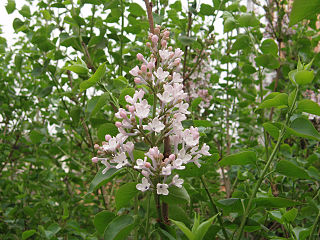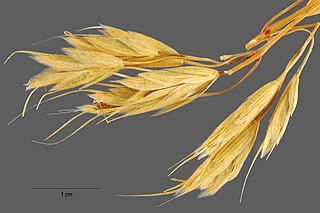
Pachypodium ambongense is a species of plant in the family Apocynaceae. It was first published as a species of the genus Pachypodium in 1924 by the botanist Henri Louis Poisson.

Bromus arvensis, the field brome, is a brome grass native to Europe and Asia. The specific epithet arvensis is Latin, meaning "of cultivated land".

Bromus hordeaceus, the soft brome, is an annual or biennial species of grass in the true grass family (Poaceae). It is also known in North America as bull grass, soft cheat, and soft chess.

Barbieria is a genus of flowering plants in the legume family, Fabaceae.

Boerhavia erecta, commonly known as the erect spiderling or the erect boerhavia, is one of more than 100 species in the genus Boerhavia L. Boerhavia erecta is native to the United States, Mexico, Central America and western South America, but now is cosmopolitan in tropical and subtropical regions. In Africa its distribution extends from West Africa, eastwards to Somalia and down to South Africa. It has recently been found in parts of Madagascar and Réunion. In Asia, it occurs in India, Java, Malaysia, the Philippines, China and the Ryukyu Islands.
Adenorandia is a monotypic genus of flowering plants in the family Rubiaceae. It was described by Vermoesen in 1922. The genus contains only one species, viz. Adenorandia kalbreyeri, which is found from west-central tropical Africa.

Syringa oblata is a species in the genus Syringa, in the family Oleaceae. It is also known as early blooming lilac or broadleaf lilac.

Ipomoea oenotherae is a species of plant of the morning glory genus, Ipomoea, in the family Convolvulaceae. It derives its name from the resemblance it bears to plants in the genus Oenothera. Ipomoea oenotherae is a succulent and a cryptophyte.

Acacia ryaniana is a shrub of the genus Acacia and the subgenus Phyllodineae that is endemic to an area along the west coast of Australia.

Vigna trilobata, the African gram, three-lobe-leaf cowpea or jungle mat bean, is a regenerating annual herb found in India, Pakistan, Sri Lanka, Burma, Afghanistan and the Malay archipelago.

Vigna hosei, also known as the sarowak bean, is a perennial legume that grows in low-lying, humid, tropical areas but more commonly disturbed or roadside areas.
Hypericum cuisinii is a perennial herb in the genus Hypericum, in the section Adenosepalum. The herb has pale yellow flowers and occurs in Greece and Turkey.

Bromus squarrosus, the rough brome, is a brome grass native to Russia and Europe. The specific epithet squarrosus is Latin, meaning "with spreading tips". The grass has a diploid number of 14.

Passiflora bogotensis is a climbing plant native to Colombia, in the genus Passiflora. It can also be found in Venezuela.

Prunus himalayana, called jyokun shin in Tibetan and 喜马拉雅臭樱 in Chinese, is a species of Prunus native to Nepal, Bhutan, Sikkim and Tibet. It prefers to grow 2,800 to 4,200 m above sea level in the Himalayas. As Maddenia himalaica it was the type species for the now unrecognized genus Maddenia.
Puccinellia laurentiana is a perennial grass which grows on gravelly seashores in south-eastern Canada. Its specific epithet "laurentiana" refers to the Gulf of St. Lawrence, where it grows.
Adenodolichos acutifoliolatus is a plant in the legume family Fabaceae, native to Tanzania.
Adenodolichos paniculatus is a plant in the legume family Fabaceae, native to tropical Africa. The specific epithet means "with panicles", referring to the plant's many-branched inflorescence.
Adenodolichos rupestris is a plant in the legume family Fabaceae, native to tropical Africa. The specific epithet means "found near rocks", referring to where the species was initially encountered.

Asclepias perennis, also known as aquatic milkweed or white swamp milkweed, is a North American species of milkweed that is found throughout the Coastal Plain from eastern Texas to southern South Carolina, northward along the Mississippi River, and into the Ohio Valley of Illinois, Indiana, and Kentucky. There seems to be a few disjunct populations in Arkansas, Texas, and Indiana.














